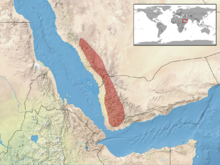Veiled chameleon
| Veiled chameleon | |
|---|---|

| |
| Scientific classification | |
| Kingdom: | |
| Phylum: | |
| Class: | |
| Order: | |
| Family: | |
| Genus: | |
| Species: | C. calyptratus
|
| Binomial name | |
| Chamaeleo calyptratus | |

| |
The veiled chameleon, Chamaeleo calyptratus, is a large species of chameleon found in the mountain regions of Yemen, the United Arab Emirates, and Saudi Arabia. It is also sometimes referred to as the Yemen chameleon.
The male veiled chameleon is primarily green in color and tends to be marked with stripes and spots of yellow, brown, and blue. Depending on the animal's emotional state, this green will range from a bright lime green to a red olive drab. When veiled chameleons are stressed, they often display strong coloration, including bright yellow and sometimes even black. Surroundings only partly contribute to a chameleon's "decision" to change color. Nonbreeding females and juvenile chameleons are generally a uniform green color with some white markings. Breeding and gravid females are a very dark green with blue and yellow spots. The prominence of these markings is dependent on several factors, including health, mood, and temperature of the lizard.
Male chameleons of the species have small spurs or heels on the backs their rear feet, while females do not. This spur is present on males from hatching, and can grow larger with maturity. Adult males are relatively large for reptiles. They can reach an overall length of 24 inches (60 cm). Most specimens usually grow to between 14 and 18 in (35–45 cm). Females are smaller, with the average overall length being just under 12 in (30 cm). Males and females both have a decorative growth called a "casque" on their heads. The casque of a male chameleon is much taller than the female's.
Like most chameleons, the veiled chameleon is a specialized tree dweller. It has a flattened body meant to mimic a leaf, and feet specially designed for grasping limbs and branches. Its prehensile tail acts as a fifth appendage and aids in climbing. Its eyes work independently of one another, allowing the chameleon to look in front of and behind itself at the same time. Its long tongue, contrary to popular belief, is not sticky, but instead has a muscular structure on the end which physically grips to capture insect prey. The veiled chameleon is an ambush predator, and is capable of lying still for very long times, waiting for an unsuspecting locust or other prey to wander by.


Veiled chameleons are omnivores. While their main diets consist of insects, they will occasionally consume the leaves, blossoms, and fruit of various plants. This is especially true in times of drought. Like all chameleons, veiled chameleons prefer to drink water in drops on leaves. They do not always recognize standing water, and may dehydrate if that is their only source.
Female veiled chameleons can produce up to three clutches of eggs a year, beginning as early as four to six months of age. Each clutch may contain 20–200 eggs. The eggs are dissimilar to chicken eggs. They retain sperm, which is why they lay so many clutches. Egg-laying sand must be provided for mature females in an incubated bucket or similar, with about 8-10 inches of organic garden soil, or they can die of egg binding.
Veiled chameleons are often kept in captivity because they are hardy when compared to other chameleon species often offered for sale; however, all chameleons require specialized care and should not be considered a beginner's reptile. Like most Old World chameleons, they must be kept individually in a screened enclosure, and provided with a basking light, and a source of ultraviolet (UVB/UVA) light. Veiled chameleons have a reputation of being more aggressive and territorial than many other chameleon species, particularly in captivity. Many experienced owners report more mellow temperaments with careful training and taming. As with all exotic pets, a qualified herpetologist veterinarian should be consulted when getting a new animal, and when any health or behavior problems are observed.

